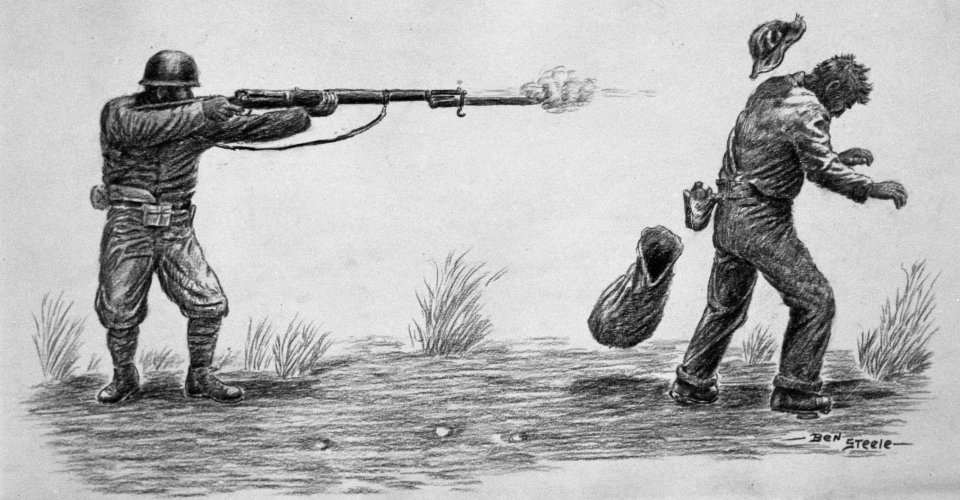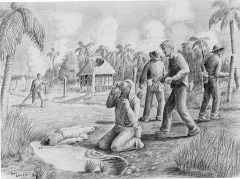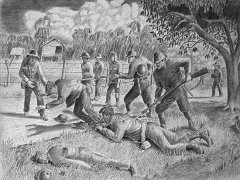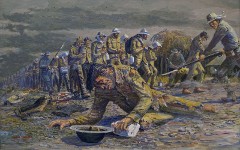I met Ben and his wife, Shirley, at the very first American Defenders of Bataan & Corregidor Convention I attended. That was 1992 in San Francisco and there were probably well over 500 attendees. At these conventions there would be day excursions to local sites—and one of these was to a nearby island. We were all standing in line, about 150 attendees, waiting to get on a ferry to return to the mainland. Throughout that day people kept urging me to find and talk with Ben Steele because of his drawings. I was sandwiched in this line of humanity waiting for the ferry when I decided to try and locate Ben. I turned around to the couple just behind me and asked "Do you know Ben Steele?" This fellow began to laugh and said something like, "yeah, you could say I am good friends with him- I'm Ben Steele." To say the least we became fast friends. I often think back about the odds of meeting Ben this way—literally finding a needle in a haystack-and realizing this was an auspicious meeting. And I have had many such encounters through the nearly two decades of interviewing these men and researching the topic. Something or someone has been guiding me forth.
Ben was born in Roundup, Montana in 1917. His parents were ranchers and Ben worked on the family ranch. After the Depression claimed his family's ranch Ben continued to worked on nearby ranches. In 1940 Ben joined the Army Air Corps and was sent to the Philippines. Ben was surrendered on Bataan and participated in the Death March in April of 1942. The Death March is seared in the memories of all who survived and many of Ben's drawings depict the Bataan Death March.
Ben, as a POW, began drawing while in the Bilibid Hospital in Manila. Ben had been on the infamous Tayabas Road Detail where nearly one third of the POW's died. Ben was brought to the hospital in terrible condition suffering from dysentery, beri beri, pneumonia and malaria and he was given Last Rites. But he survived and while recovering he began to sketch on the cement floors of the hospital with charcoal. First were cowboy scenes and later he began to draw life as a POW. Drawing would be one of his survival mechanisms. He had to be very careful not to be caught by the Japanese since many of his drawings documented the brutal treatment by them.
Ben, like many of his buddies, was destined to be shipped to Japan as a slave laborer. Ben left his drawings with Father Duffy a Catholic Priest for safe keeping. Unfortunately, Father Duffy was later shipped out on the Oryoku Maru for the same purpose. But the ship was bombed and sunk by American Bombers and the drawings were lost, although Father Duffy survived.
After the war Ben was encouraged to continue to pursue art by his psychiatrists and enrolled at the Cleveland Institute of Art. He continued his studies and graduated from Kent State with a BSE and a MA degree from the University of Denver. He became a professor of art at East Montana College and taught there 22 years. Ben recreated the drawings that had been lost and are now known as The Ben Steele Prisoner of War Collection.
Ben's art is valuable documentary evidence of a horrific time in history, and I am grateful that he has permitted me to use his work in my documentary projects.
Ben Steele is featured in the New York Times bestseller-Tears In The Darkness by Michael and Elizabeth M. Norman.
Ben donated his Prisoner-of-War Art Collection (over eighty pieces) to the University of Montana. It will be on exhibit from September 23-November 19, 2011 at the Montana Museum of Art & Culture.




